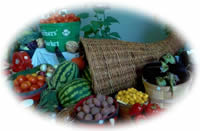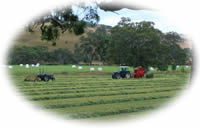
Grades 3-5

Don't have an account yet? Sign up for free
Don't have an account yet? Sign up for free

Students learn how community supported agriculture (CSAs) is changing the relationship between the farmer and the consumer.
Most people get their fruits and vegetables from the grocery stores. But increasingly there are alternatives for consumers to get agricultural products.
get agricultural products.
Instead of the producers (farmers) bringing their goods to the market, more consumers are heading to the farm.
Ask the students where they get the majority of their fruits and vegetables? When you mention buying fruits or vegetables, most people assume you mean that you buy them from a supermarket. Tell the students that there are other options now available for buying their groceries directly. Use the example that if they wanted some fresh cranberries to make cranberry sauce for Thanksgiving, where could they go instead of a grocery store? To see some choices, have the students look at the "https://www.localharvest.org/clifton-nj " website. Have them type in "cranberries" in the description of product category and do a search. Ask them what they found? [Answers vary]. Tell them that as they can see, many of the choices involve picking your own cranberries.
Now have the students type in the names of other food items they might like to find or look at. Tell them that their is the product list to see what items are available. Check to see if there any products that they think might be available near where they live. Depending on where they live, they may have a great many choices or they may have none at all.
Tell the students that consumers have been getting produce and other items from farmer's markets and family farms such as those above for some time. 
Tell the students that a relatively new approach that also brings consumers and producers (farmers) together is the CSA (community supported agriculture).
Explain to them that a CSA is a group of individuals that support a farm operation so that the crop grown really belongs to the consumers. Tell the students that in most cases, supporters (consumers) make a pledge to support the farm throughout the year by buying a share of the season's harvest. The price paid is usually the cost of running the farm divided by the members in the community. Members help pay for seeds, fertilizers, water, equipment, and labor. In return, the members receive seasonal fresh produce throughout the growing season. CSA farmers often use organic or biodynamic farming methods. Most CSAs produce a diversity of vegetables, fruits and herbs. Many also offer eggs, meat, milk, baked goods and even firewood to their members. There are no middlemen, packing or transportation costs. Some members even participate in the farming operation to keep costs down. If the farmer produces more than is needed by the members in the CSA, the members would need to decide who gets the additional money if the overage is sold. CSAs are generally developed in conjunction with small farms but could be adapted to larger operations.
Tell the students that CSAs do not represent a true market economy. In a market economy, production decisions are made by entrepreneurs acting in what they perceive to be their own best interests. Individuals seeking profits are free to produce whatever good or service they desire. Consumers will decide if they will buy this good or service. Competition forces producers to use efficient techniques of production and to respond to changing consumer preferences. Businesses that are inefficient will lose customers to their competitors. CSAs essentially eliminate the competition and would seem to eliminate the incentive for efficient production. However, in the long run, if CSAs are not efficient in satisfying consumers, consumers will then leave the CSA and probably return to more traditional markets.
Explain to the students that CSAs can be found in many states. To see if there are any CSAs near the students, have them look at the Department of Agriculture's site on community supported agriculture. If there are none in their state, see if there are any in a neighboring state. Ask the students if they think people in their community would join a CSA if one were available?
Have the students complete the following Interactive Benefits Activity, and have them match which benefits are benefits to the consumer, which are benefits to the producer, and which are benefits to the local community.
| [Answers to Interactive Benefits Activity: | ||
|
BENEFITS TO CONSUMER |
BENEFITS TO PRODUCERS |
BENEFITS TO LOCAL COMMUNITY |
|
Produce may be at below retail price High quality and freshness May be organically grown |
Price received covers costs of production No time spent finding buyers Little or no transportation cost Guaranteed market Preserves small farms |
Keeps food dollars in the local community Maintains a more diversified agricultural community Support of a local business ] |
Have the students complete the following Interactive Costs Activity, and have them match which costs are associated to the consumer, which are costs to the producer, and which are costs to the local community.
| [Answers to Interactive Costs Activity: | ||
|
COSTS TO CONSUMER |
COSTS TO PRODUCERS |
COSTS TO LOCAL COMMUNITY |
|
Increased shopping time due to inconvenient location Possibly higher cost than in grocery stores Less selection Long-term commitment |
Possibly lower price received than current market price More different crops to manage Less control over production decisions |
May adversely affect other businesses (local grocers) May not generate highest revenues or taxes May not be highest use of the land] |
Explain to the students that in order for any market to be successful, both producers and consumers must satisfy their needs. Use the example of the farmer who wants to make a profit from his crop. [Profit = Revenues – Cost.] A consumer wants a quality product at a good price. If the farmer produces more than is needed by the members in the CSA, the members would need to decide who gets the additional money if the overage is sold.
To see how an actual CSA works, let's consider a typical example. Farmer Bill of Green Acres Farm can grow a variety of fruits and vegetables on his farm and the growing season is about seven months long. To grow the widest variety of produce, Bill estimates it will cost him about $175,000, which includes his labor costs and desired profit. He can deliver produce once a week for 32 weeks. If he expects to sell "shares" in this CSA to 200 local consumers.

Grades 3-5

Grades 9-12

Grades 9-12

Content Partner
Grades 3-5
